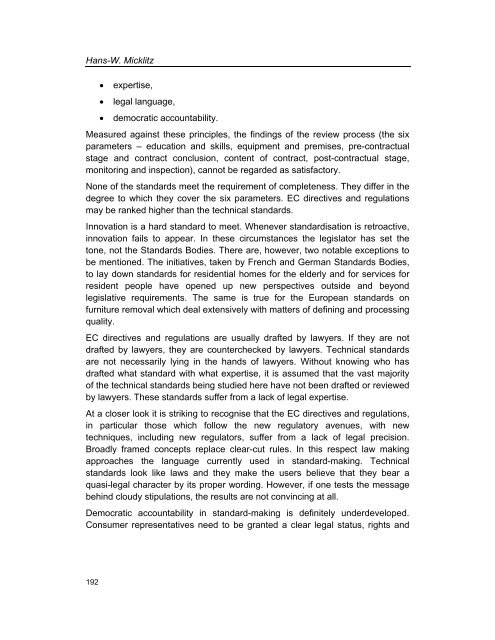Services Standards: Defining the Core Consumer Elements ... - ANEC
Services Standards: Defining the Core Consumer Elements ... - ANEC
Services Standards: Defining the Core Consumer Elements ... - ANEC
Create successful ePaper yourself
Turn your PDF publications into a flip-book with our unique Google optimized e-Paper software.
Hans-W. Micklitz<br />
• expertise,<br />
• legal language,<br />
• democratic accountability.<br />
Measured against <strong>the</strong>se principles, <strong>the</strong> findings of <strong>the</strong> review process (<strong>the</strong> six<br />
parameters – education and skills, equipment and premises, pre-contractual<br />
stage and contract conclusion, content of contract, post-contractual stage,<br />
monitoring and inspection), cannot be regarded as satisfactory.<br />
None of <strong>the</strong> standards meet <strong>the</strong> requirement of completeness. They differ in <strong>the</strong><br />
degree to which <strong>the</strong>y cover <strong>the</strong> six parameters. EC directives and regulations<br />
may be ranked higher than <strong>the</strong> technical standards.<br />
Innovation is a hard standard to meet. Whenever standardisation is retroactive,<br />
innovation fails to appear. In <strong>the</strong>se circumstances <strong>the</strong> legislator has set <strong>the</strong><br />
tone, not <strong>the</strong> <strong>Standards</strong> Bodies. There are, however, two notable exceptions to<br />
be mentioned. The initiatives, taken by French and German <strong>Standards</strong> Bodies,<br />
to lay down standards for residential homes for <strong>the</strong> elderly and for services for<br />
resident people have opened up new perspectives outside and beyond<br />
legislative requirements. The same is true for <strong>the</strong> European standards on<br />
furniture removal which deal extensively with matters of defining and processing<br />
quality.<br />
EC directives and regulations are usually drafted by lawyers. If <strong>the</strong>y are not<br />
drafted by lawyers, <strong>the</strong>y are counterchecked by lawyers. Technical standards<br />
are not necessarily lying in <strong>the</strong> hands of lawyers. Without knowing who has<br />
drafted what standard with what expertise, it is assumed that <strong>the</strong> vast majority<br />
of <strong>the</strong> technical standards being studied here have not been drafted or reviewed<br />
by lawyers. These standards suffer from a lack of legal expertise.<br />
At a closer look it is striking to recognise that <strong>the</strong> EC directives and regulations,<br />
in particular those which follow <strong>the</strong> new regulatory avenues, with new<br />
techniques, including new regulators, suffer from a lack of legal precision.<br />
Broadly framed concepts replace clear-cut rules. In this respect law making<br />
approaches <strong>the</strong> language currently used in standard-making. Technical<br />
standards look like laws and <strong>the</strong>y make <strong>the</strong> users believe that <strong>the</strong>y bear a<br />
quasi-legal character by its proper wording. However, if one tests <strong>the</strong> message<br />
behind cloudy stipulations, <strong>the</strong> results are not convincing at all.<br />
Democratic accountability in standard-making is definitely underdeveloped.<br />
<strong>Consumer</strong> representatives need to be granted a clear legal status, rights and<br />
192
















